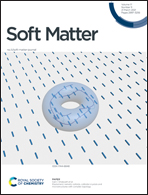Robotized algal cells and their multiple functions†
Abstract
From an engineering perspective, algal cells with the abilities of perception and driving can be considered as microrobots. Site-specific, quantitative assembly of algal robots and the manipulated objects and collaborative task performance by algal robots would benefit biomedicine, environmental monitoring, and micro-nano manufacturing. Herein, site-specific, quantitative assembly and drive of algal cells are investigated. The mechanism of cell movement is analyzed, and cell motility is evaluated with or without light control. To robotize algal cells, an algae-guiding system is built, through which a swarm of algal cells is controlled to follow trajectories. By the cell adhesion method, adhesion and release between algal cells and microstructures are achieved. Algal cells successfully transport microspheres and release them at a destination. The cells are continuously operated for 60 min while carrying microspheres and they travel up to 270 mm. An optical guiding method is then developed for controlled assembly of algal robots onto fabricated micro-objects. The rotational movement of the microstructures is realized through cooperative driving by algal cells. This research provides a new biological driving method based on algal cells, which swim and behave as microrobots and are expected to benefit microassembly, microcargo traverse/delivery, and biological collaboration.



 Please wait while we load your content...
Please wait while we load your content...